We all judge books by their covers. Let’s just admit it. Despite our best intentions to give something the benefit of the doubt, we all make snap decisions based on first appearances and our own personal filters. It’s one of the reasons why board games sport such amazing box art (and sometimes why boxes are way bigger than they need to be). If publishers want your interest after nothing more than a cursory glance, a catchy cover is a big plus. I try to curb initial judgments whenever possible, but we sometimes fail despite our best intentions. So it was with Pacific GO, a light wargame from Big Cat Games.
I’ll admit I have only myself to blame. I had expectations, hopes. I knew next to nothing about Pacific GO other than its basic premise: a wargame set in the Pacific during WWII. It’s “cover” if you will. In a genre dominated by Western designers, here we had a game coming from a new voice. The opportunity to review a WWII wargame made by a Japanese designer! How could I pass that up? Excitedly I requested a copy for review. I may not have passed judgment on the game itself at that point, but I’d certainly formed a set of hopes for what I’d find. And having expectations can lead to disappointment.
That disappointment isn’t a bad thing in itself, and it’s not even a negative reflection on the game. But it’s definitely a consideration for who this game might best suit. I’ll show you what I mean.
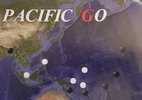 Pacific GO
Pacific GO
Designer: Wataru Horiba
Publisher: Koubou Horiba
Format: Abstract Strategy, Area Majority/Influence, Action Points
Number of Players: 2
Play Time: 90 minutes
Price: $28
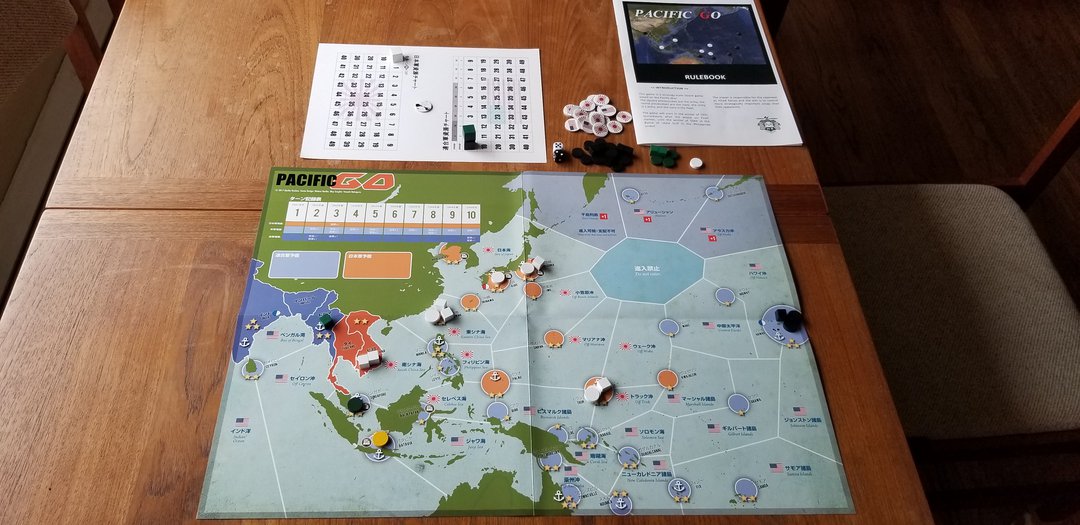
Everything you get with this game. A board, some wooden pieces, the resource tracker, and a rulebook. Nice and light!
Still Solid
I’m going to do things a little out of order here and tell you what I think of Pacific GO up front. As a reminder, we tend not to review games unless we’re excited about them, if we feel it’s good for someone in some way. So in terms of this being a light simulation of the Pacific War, it’s totally fine! This is a solidly built little title, fitting in perfectly with the standards I’ve come to expect from what Big Cat Games brings overseas. Mechanically, Pacific GO is designed to show how resources were needed to do everything, and how a lack of resources or disrupted supply lines could spell disaster for the movement and combat potential of each side’s fleets and soldiers.
Each side uses resource points to move forces around the board, taking it in turn to pass play back and forth, spending as much or as little as they’d like until both sides pass consecutively. Battles are then resolved, both naval and then land, domination of various areas is rechecked, resources are gathered, new forces are produced from remaining resources, and finally any forces lingering around the board must withdraw to a friendly port (where they will branch out from again the next turn). Japanese and Allied forces play asymmetrically, though. Japanese pieces pay a resource point per space to move while the American fleet pays one point for its entire move (regardless of the number of spaces). Japanese supply comes from a number of set locations on the board they must control while American supplies are granted automatically via a turn track that ramps up across the game. Japan also starts the game with twenty resource points while the US starts with zero. The game is over after 10 turns, and the Allies only win if they have 10 points or more than the Japanese. Additionally, if either side should dominate both of the other’s home base locations, the game is immediately considered won.
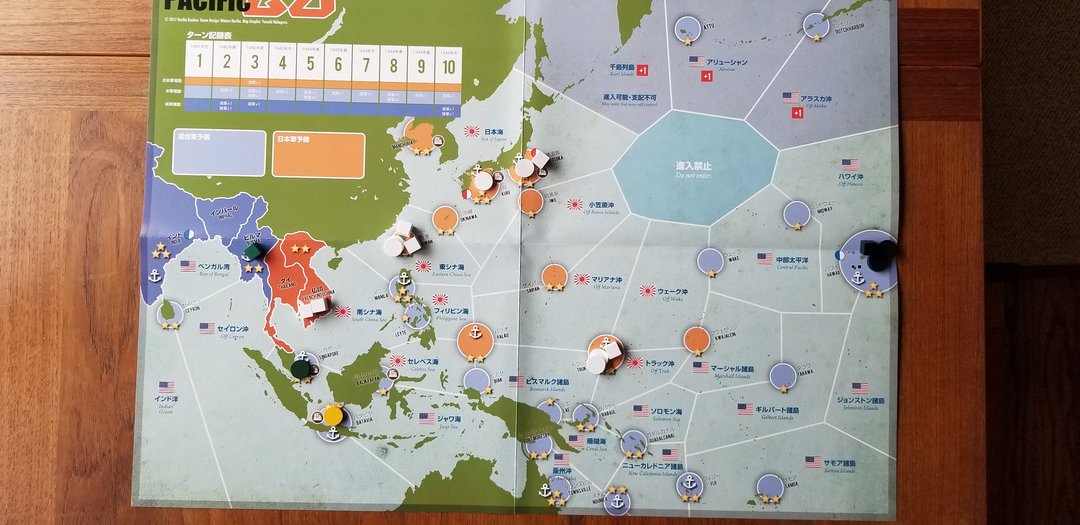
Close up of the board. Initial setup featured.
This game, as a simulation, hammers home the importance of resources. You need them to move, and the Allied player instead pays per space (like the Japanese) if forces can’t trace a supply line of dominated territories back to their home base. The Japanese only receive their resource income if they can trace a similar supply line from conquered resource areas back to their own base. You spend resources to better your chances of successful combat rolls, as well as to roll dice in combat to begin with, and if your forces are cut off from a supply line to your home base? You guessed it! You pay double resource points to fight. Defeated units that aren’t killed normally retreat to friendly territory, but if you don’t have a supply line? Yep, you have to pay to save them or they’re removed from the game. You quickly learn that if you want to win this war, it’ll be a little more complex than simply moving your armies to the spaces worth the most victory points.
Much like its namesake, Pacific GO plays a little like GO, a simple game of black and white stones encircling each other for control of territory. What you’ll find here is a game of swiping supply lines out from advancing forces, using the opportunities presented to advance your territory domination towards much needed supply or victory points. Occasionally you’ll engage in large head-on battles, though like any good general you’ll soon realize forces are expensive to produce and support, so every battle will need to count. It pays to know when to cut your losses or spread the offensive on a new front. Throw your troops away at meaningless confrontations at your own risk! Fighting over supply earns you zero points towards your victory, except for the fact that without it you’ll have no means of chasing said victory when you’re ready. When you choose to lunge for one or the other then is a fine balance that’s handled quite well.
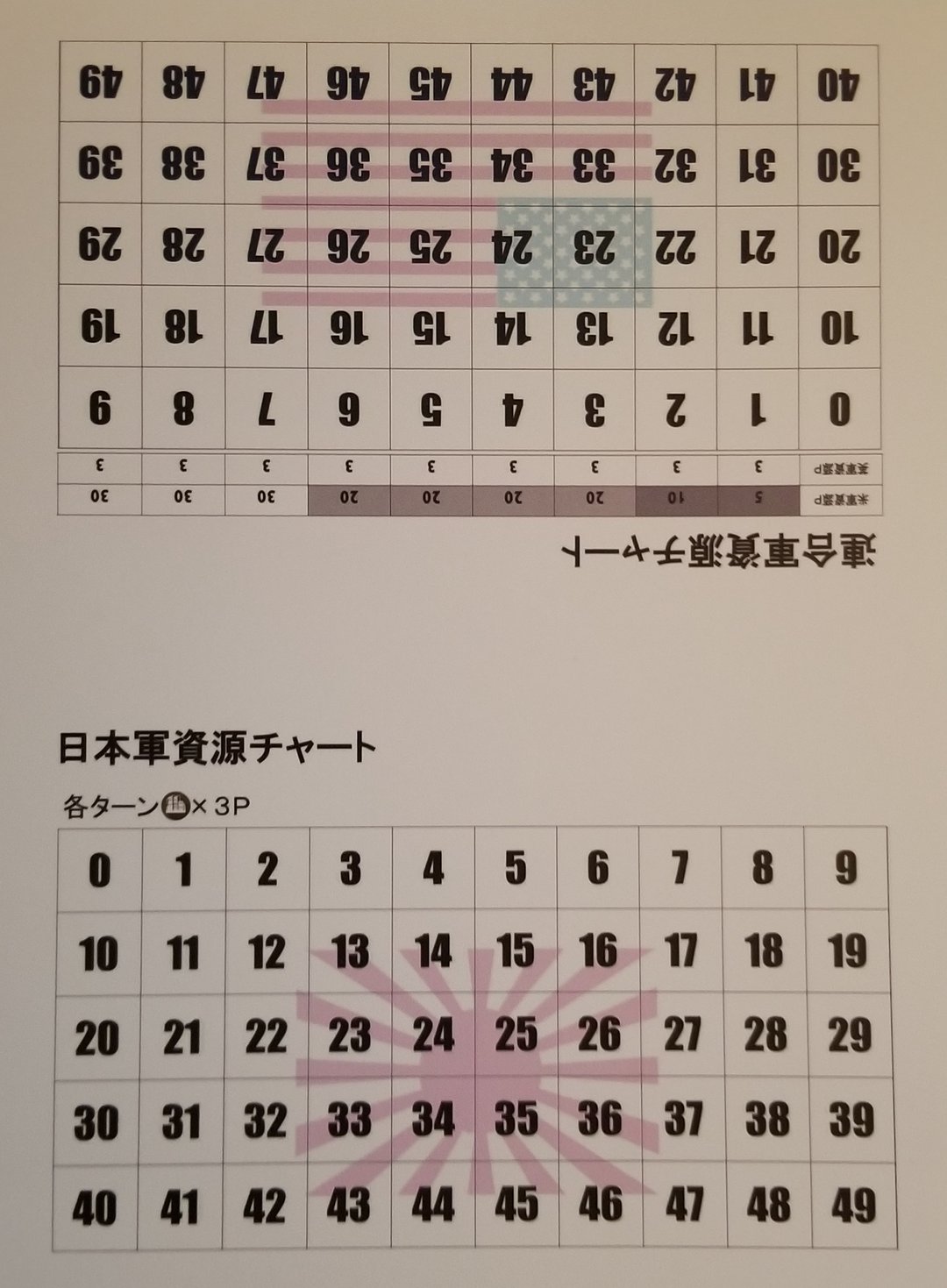
The resource chart, even if you don't read Japanese, has a reminder that Japan gets 3 resource points per symbol it's captured. The US side has their earned values printed right along the top of their chart.
Only A War Game
Up until now I’ve been talking about Pacific GO strictly on its game-play. And for me, that’s where game talk ends and my criticisms start. Again, part of that is on me for having certain expectations. You see, what excited me most about this WWII game was to see the conflict portrayed from a side that’s horribly underrepresented in this genre. Often the Allied forces are painted as heroes, and certainly if you’re punching Nazis in Fortune and Glory, one can easily make that case. But war is a grey area, and American forces did their fair share of less-than-great things during their years fighting. So when I learned that a Japanese designer was making a game about the war in the Pacific, I was really eager to see what he would highlight. Yes, I got my hopes up before I did my homework, so when all I found was a cut and dry simulation of war and supply, I was very let down. It’s a very tight little simulation of war and supply, don’t get me wrong, but also don’t make my mistake.
The very first time I rolled this game out, I didn’t even end up playing it. My friend and I ended up getting into a 30 minute discussion about what was represented by Japan having a resource collection point in Singapore. Sure, the game itself stands as a fantastic representation of how resources fed the war effort of both sides during WWII, but in doing so it also glosses over any sensitivity to what's implied on the board. Did my friend want to win as Japan? That mean they were going to have to conquer and occupy. It was a bit disheartening, and it took some time before I could bring the game out to play again.
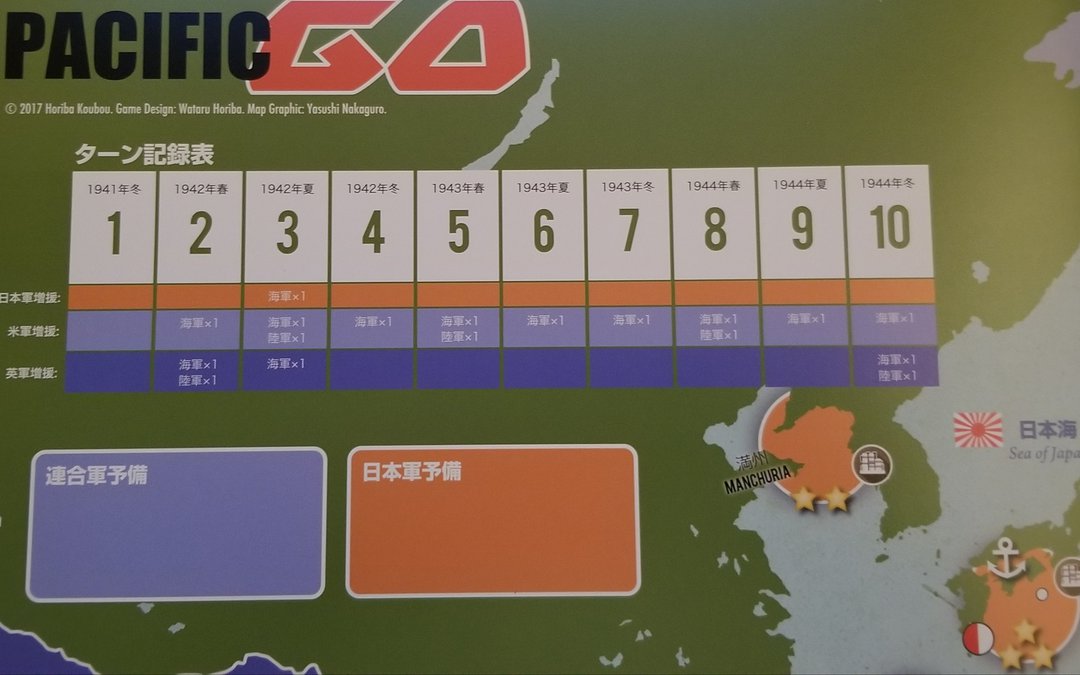
The reinforcement track is where you'll take extra pieces that have been set aside each turn. There's help online for translation, but the rulebook also reminds you what forces go where, so it's not hard to learn how to read which are army and which are navy.
That is, perhaps, my biggest personal concern for who this game will best fit. If you’re the type who was bothered by the colonial theme of Archipelago or the slavery mechanic in Endeavor: Age of Sail, while this game isn’t so overt in its use of less than savory themes I still think it warrants some consideration on the part of the buyer. If, on the other hand, you’re OK with a simulation wargame just for the sake of strategy, you’ll likely do just fine with Pacific GO. I’ll say again that the use of resources and how they dovetail into your grand strategy really is very well done and not like many other wargames I’ve seen. That alone may be worth your time.
The rulebook and components also bear some consideration. The board itself is a thick, folded paper which you may find yourself wanting to mount onto a proper board if you play a lot. The pieces are all cubes and disks, which are perfectly functional. Just know that you’re not getting into any fanciness when it comes to components here (though for the sake of keeping costs low you may also consider this a plus). And then there’s the rulebook. It’s only 7 pages of rules. Big font, pictures, the kind of thing that an experienced gamer can usually breeze through in 15 minutes or less. I had to reread it several times before I could come to grips with the game concepts enough to feel comfortable teaching. The book has examples with unclear pictures and confusing wording which make it difficult to pick up what is otherwise a rather simple rule set. Just as one example, here’s a phrase that appears in the rules for land combat: “When landing, land all the first attacking pieces, and then land the second attacking piece.” You’ll eventually put everything in context as you go back and forth with the rules, but for as streamlined of a game as this is, it’s something of a bear to learn the first time unless you have someone teaching you.
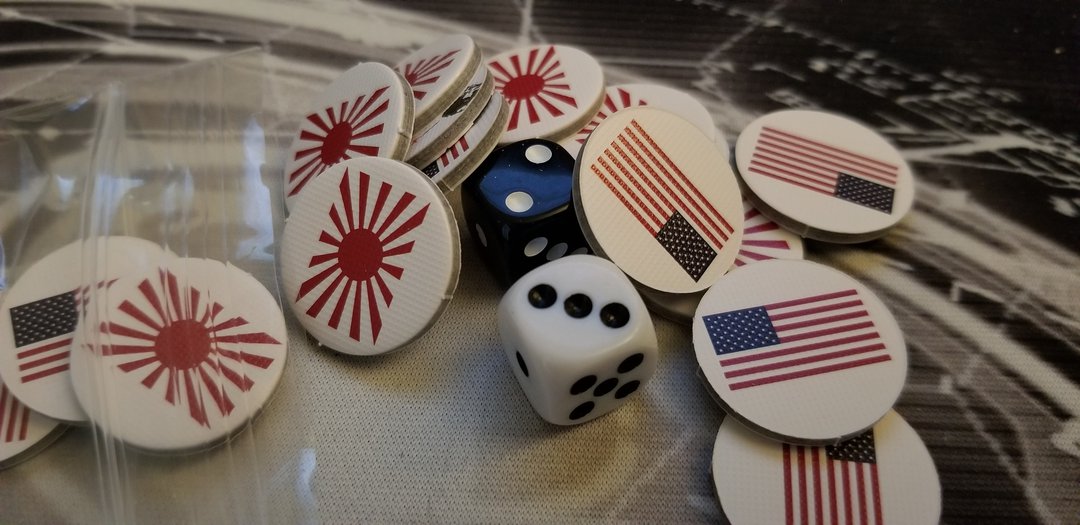
Close up of the dominance markers. As a reminder, Big Cat Games does cardboard right. These pieces are nice and thick!
Is It For You?
If you’ve checked out my reviews of Hiktorune or Nokosu Dice, or even my preview of FILLIT, you’ll probably have a sense now that Big Cat Games is getting something of a reputation for bringing high quality games from Japan to the wider world. Pacific GO is no exception to this rule. It’s got solid design and very cleverly brings to the forefront how resources are essential to winning a war, an angle I’ve not seen many designers tackle with such finesse. But you have to ask yourself some serious questions as a potential purchaser. Are you the kind of gamer that makes little stories about what’s happening in-game given nothing more than pushing a few cubes around? If so, you might be a little put off by the Japanese player’s requirement to take resources from other countries. Are you willing to sift through the rules a few times, perhaps setting up the play examples on the actual board because the photos cut off some of the territory names and you’re having trouble visualizing the setup? There are no learn to play videos online to help you with this one (at least at the time of writing).
Ultimately, though, if none of this bothers you in the slightest, then I’d say you’ll probably be fine with Pacific GO. If you’re sitting at home thinking “I wish I could get a light, fast wargame on my shelves,” or “I love wargames, but I wish I could get one with a take that’s more than just armies and combat rolls” I think this game will make an excellent addition to your shelves.